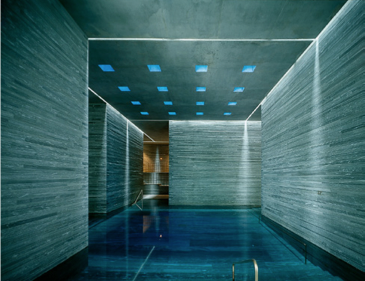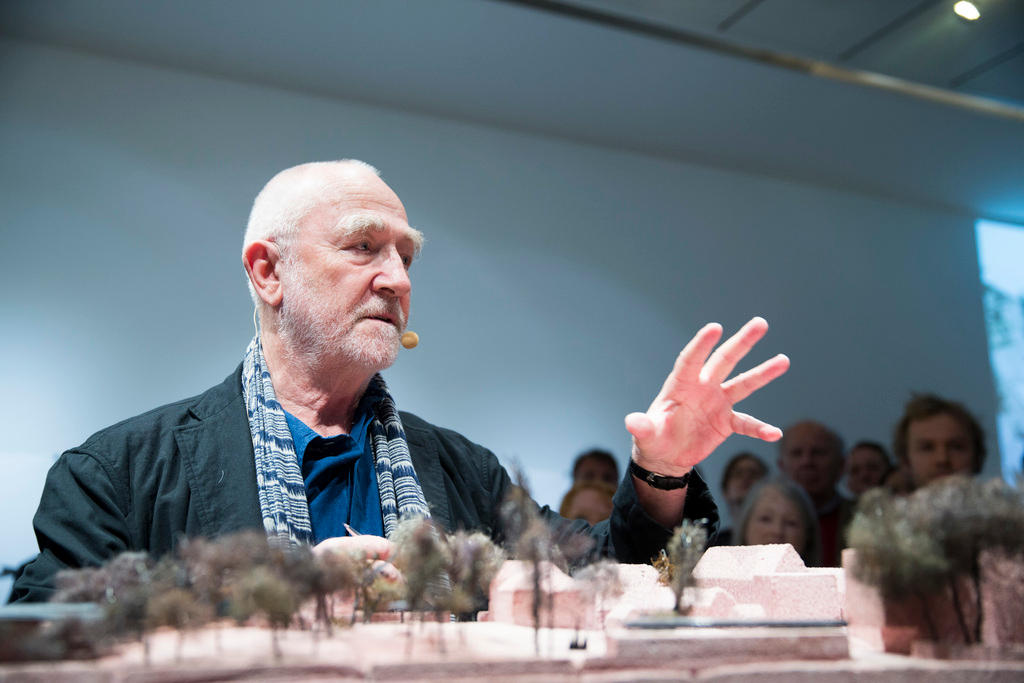‘I had to learn that failing goes with the job’

Peter Zumthor, the Swiss architect behind the new Los Angeles County Museum of Art (LACMA), explains how hard it is to accept democratic processes.
Besides his work on LACMAExternal link, he is planning his first high-rise in Belgium. On July 1, Zumthor was awarded this year’s prestigious BDA Grand Award External linkin Germany.
This is what the German jury for the BDA prize had to say about the Swiss architect: “His work takes architecture back to humanity’s ‘original creations’.” Better than anyone, it says, this self-confident hermit knows “what building and sheltering originally meant”. Zumthor has also won the coveted Pritzker prize for architectureExternal link. His commitment to quality and attention to detail, they say, “give his work timeless validity”.
SRF: What inspires you?
Peter Zumthor: Images, moods, a feeling for the place. That also includes listening, finding out what the client wants and what the assignment requires. And picking up discordant elements as well. Sometimes I have to ask: Is that really what you want? Naturally I always take great pleasure in location. Building houses that contribute to the quality of the location just by being there, that somehow improve or endorse it: that is my great passion. Perhaps even making something visible that had been lost to sight, a piece of the location’s lost history.
SRF: How about building bridges? Would that also be something you could do?
P.Z.: I can’t, but I love bridges. I’ve just seen a picture of the new Tamina Bridge, a lovely arch bridge. I’d love to design buildings with the same logic. With the loveliness that is created by the logic of their design. The building in Los Angeles that I’m currently working on has something of a huge bridge about it, with its enormous pillars. That’s why I’m working on it in close cooperation with engineers. It’s a fantastic collaboration, because we talk about the building’s structure and statics.
SRF: There’s an interplay of light and shade in your buildings that you call “calm space”. What’s that?
P.Z.: Sometimes you come across films or books that make you feel the author is constantly showing off how great he is. That’s not my style. I like to blend into the background, so that people come to love the building as time passes.

SRF: What aspect of project work do you most enjoy?
P.Z.: Building is great. Watching 20, 200 or 2,000 people create something, seeing how all their skills are needed – that makes me proud. And the pleasure it gives me is like that of a conductor able to work with a variety of instruments. The beginning is lovely too. It’s always the initial idea that’s most exciting. And that excitement is what keeps you going as an architect throughout a long process, a process that you must get through no matter what difficulties you encounter along the way.
SRF: How do you deal with failure?
P.Z.: I had to learn that failing goes with the job. Nobody told me that. There are awful moments. When I had to watch the first stair towers of the Topography of Terror museum in Berlin being demolished, I had tears in my eyes. And I sometimes despair of certain Swiss democratic processes.
SRF: One of your key works is the Vals spa complex. Your attempt to buy it was unsuccessful: the municipal assembly accepted another offer. What do you think of that now?
P.Z.: In retrospect, I’m glad it didn’t come off.

SRF: The plan now is for a 300-metre tower by Thom Mayne in Vals. What do you think of this project?
P.Z.: Thom Mayne is a good, interesting architect. Twenty-five years ago, we taught together at a university in Los Angeles. I was most impressed by him. He often used to say things in response to criticism that I didn’t understand at all – and when I looked round, I could see that our colleagues and the students didn’t understand what he meant either. Los Angeles has several fantastic buildings of his. But this commission [for the Vals tower] involves a setting he is totally unfamiliar with. A gigantic tower in a mountain village? I have to say no.
SRF: A project for a music hotel in Braunwald was recently turned down by the municipal assembly, and it’s now hanging in the balance. What do you think of that?
P.Z.: It’s the same problem: you have to be patient. The vote wasn’t about the hotel itself, it was about the water plan – though the two were connected. The town now has the opportunity to put the project back on the rails, and in an improved form. I still believe in it.

More
Swiss architect’s most famous works
SRF: You are currently working on the LACMA, a $600 million project scheduled to begin construction next year. How do you handle your activities abroad? Is it all done from your office in the village of Haldenstein in Graubünden?
P.Z.: First: I need clients who enjoy working with me through a process that will give us more knowledge at the end than we had at the beginning. I don’t implement existing ideas. I need people who get their kicks from developing something together. That’s what I have in Los Angeles, and elsewhere too. There’s no other way.
Second: communication has become incredibly easy. I can send the largest plan flyers to Los Angeles or New York simply by pressing a button. Putting a large team together is wonderfully simple too. It doesn’t matter where you are. The architect has to be in a place where he can do good work, and for me that’s Haldenstein.
SRF: You work like a small architectural practice. Every project goes through you.
P.Z.: I create architectonic originals. I can’t deliver things under a company name. I enjoy inventing buildings down to the last screw. But they don’t have to be small, they can also be large.
SRF: Does a relationship persist between you and the building?
P.Z.: It may be like with children. But they belong to other people. I can’t visit them, I can’t simply go there even though I’d like to. I’d have to go there in secret or at night. But there’s also fear of contact. I don’t like being in places where people look at me and whisper: look, that’s Zumthor.
SRF: In 2009 you were awarded the Pritzker Prize for your life’s work, the highest accolade an architect can achieve. What effect did that have on you?
P.Z.: It helped me to be even calmer. Throughout my career, I could never complain about not being recognized. I always have been. There have always been people who saw what I was doing and what was important to me. And there have always been others who stuck a label on me: Zumthor – difficult, pig-headed. You just have to put up with it.
SRF: Did this recognition put you under pressure to perform at the same level?
P.Z.: No, the Pritzker Prize is just the wrapping. On the inside, nothing has changed. Inventing every building from the ground up, pursuing the idea to the very end and putting it into practice in the construction sector as well as politically and culturally – it always starts at square one, and it’s always the same challenge. That doesn’t change. Once again, I’m uncertain, once again I haven’t a clue, and I say: “Damn it, something’s not right, what’s the matter?” And I talk to my people about it.
SRF: Even before you were awarded this prize, people talked of you as a “star architect”.
P.Z.: I don’t like that. I have absolutely no pretensions to stardom. The existence of star architects does architecture no good. I’d prefer it if there were star plumbers.
SRF: Art galleries, sacred buildings, spas, barracks: is there anything else that Peter Zumthor would like to design?
P.Z.: At the moment, we’re looking at whether we can build a high-rise in the south of Antwerp. The problem with all high-rises is that they don’t know how to deal with people at the base, or how they should be entered. We want to find a solution that will benefit both the town and the park. I’d like to build something on the shore, with a wide horizon.
SRF: And when you decide you don’t want to carry on, will that mean the end of the Peter Zumthor architectural practice?
P.Z.: I don’t want to compare myself with Alberto Giacometti, but since his death there have been no more Giacomettis.

In compliance with the JTI standards
More: SWI swissinfo.ch certified by the Journalism Trust Initiative











You can find an overview of ongoing debates with our journalists here . Please join us!
If you want to start a conversation about a topic raised in this article or want to report factual errors, email us at english@swissinfo.ch.